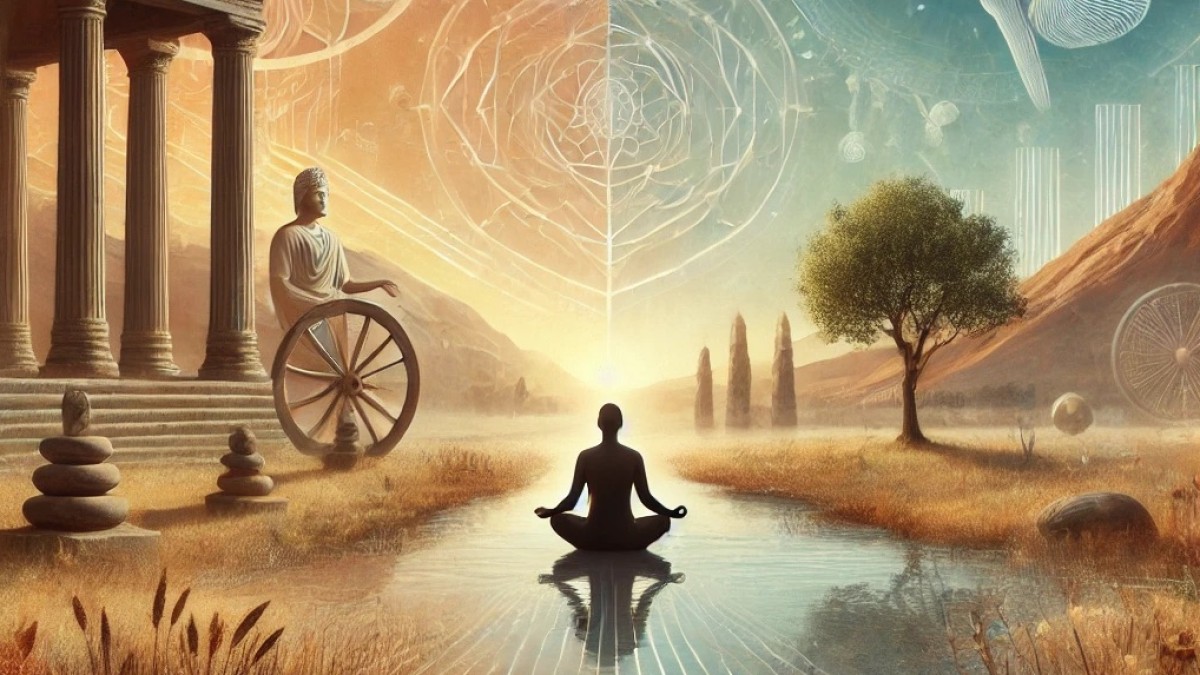Ancient Wisdom for Modern Living: How Yogic Gunas and Polyvagal Theory Align

Lately, I’ve felt drawn back to the ancient yogic and Ayurvedic philosophies I studied years ago with my teacher Pujan. At the same time, my fascination with the mind and nervous system has led me to explore polyvagal theory. The more I read, the more I think...
Wow, people back then had already mapped out how the nervous system functions long before neuroscience even existed.
Long before fight, flight, freeze, and fawn became wellness buzzwords, ancient yogis described three fundamental qualities or energies, known as gunas, that shape our thoughts, emotions, and experiences. The wild part? It aligns so beautifully with some modern theories.
I’m not an expert, just a curious explorer who loves applying what I learn for myself and clients. My hope is that this simplified perspective on gunas and polyvagal theory sparks your curiosity and offers a fresh way to live with more safety, connection, and intention.
The Three Gunas: A Yogic Map of the Nervous System
The Sanskrit word guna means strand or quality.These three forces of nature supposedly exist in everything - your food, relationships, habits, and most importantly, your mind.
🔥 Rajas... Go, go, go!
It is the energy of action, movement, ambition, and transformation. When balanced, it fuels motivation and drive. When excessive, it manifests as overthinking, anxiety, perfectionism, frustration, restlessness, and burnout.
🌑 Tamas... I can’t do anything.
It's the energy of inertia, heaviness, stillness, and darkness, ultimately ignorance of reality. When balanced, it allows rest, recovery, and integration. When excessive, it shows up as lethargy, confusion, depression, procrastination, avoidance, and self-doubt.
✨ Sattva... Clarity, creativity, flow.
It is the energy of peace, wisdom, and harmony. It allows you to feel calm, centered, open, and deeply connected. This is the state where creativity, joy, and deep presence naturally arise.
Sounds familiar? These three states closely resemble how modern neuroscience describes the nervous system.
How This Connects to Polyvagal Theory
Dr. Stephen Porges’ Polyvagal Theory revolutionized our understanding of the nervous system, explaining that our body shifts between three main states.
Sympathetic Nervous System = Fight or Flight (Rajas)
- Your body is on high alert, flooded with stress hormones.
- You feel driven, restless, reactive, or anxious.
- You might be overworking, doom-scrolling, or trying to do all the things at once.
Dorsal Vagal Shutdown = Freeze Mode (Tamas)
- Your body shuts down to conserve energy.
- You feel heavy, stuck, numb, or dissociated.
- You might be procrastinating, avoiding, or isolating yourself.
Ventral Vagal State = Safety & Connection (Sattva)
- Your body feels safe, open, and connected.
- You feel present, engaged, and at ease.
- This is where creativity, intimacy, and deep work happen.
See the pattern? 💡
What ancient yogis called rajas and tamas, modern neuroscience calls sympathetic and dorsal vagal states. And what yoga calls sattva, polyvagal theory calls the ventral vagal state - the state of creativity and thriving.
Rajas & Tamas in the Modern World
🔥 The Modern World Runs on Rajas
- Hustle culture.
- Always being “on.”
- Productivity as self-worth.
- Fast food. Drinks to-go. Same day deliveries.
- A never-ending cycle of more, better, faster, different.
Rajas makes us fee like we're thriving, but really, we're just racing toward burnout. And when we finally crash?
🌑 We Fall into Tamas
After too much rajas, the body collapses into tamas.
- You hit a wall.
- You feel exhausted and numb.
- You scroll mindlessly, binge-watch, or procrastinate.
- You want to do something, but just can’t.
And the cycle repeats: push, burn out, crash, repeat.
Why so much self-help advice falls flat is because it often ignores the reality of your nervous system. You can’t just affirm or mindset-shift your way out of a dysregulated state. But that doesn’t mean rajas and tamas are the enemy.
These states aren’t bad, they’re part of being human. The key isn’t to eliminate them but to build awareness. To be honest about where you are and choose, mindfully, how to respond. A flexible nervous system allows you to flow between states instead of getting stuck in one. And the beautiful thing? You can cultivate this awareness even while burning in rajas or hiding in tamas.
How to Shift Your State: Breath, Movements & Small Changes
One of the fastest ways to shift your state is through the breath.
Think of it as the remote control for your nervous system: inhales activate, exhales calm.
You already have tools and practices that work for you. Keep refining them. But if you need inspiration, start here:
If You’re Stuck in Rajas (Overdoing, Overthinking, Anxiety)…
💨 Your practice = Slow down. Ground. Pause.
- Breathe: Make your exhales longer than inhales (humming or sighing helps).
- Move: Slow yoga, nature walks, restorative practices.
- Simplify: Reduce input (yes, people and new courses too). Turn off notifications, take breaks from screens.
- Start small: 1-minute pauses between tasks, sit with your drink instead of taking it to-go, 10-min single-tasking rounds.
- Reflect: What am I running from? What am I chasing?
If You’re Stuck in Tamas (Confusion, Lethargy, Procrastination, Shutdown)…
⚡ Your practice = Wake up. Add warmth. Fire. Move.
- Breathe: Energising breathwork (longer inhales, Ujjayi, Kapalabhati, and Bhastrika - skip if pregnant or have other health concerns and focus on deep belly breaths instead).
- Move: Get your heart rate up - shake, dance, walk briskly, cold showers.
- Connect: Energy is contagious. Reach out to someone uplifting.
- Start small: Open a window, splash cold water on your face, do 10 squats, listen to a song that moves you. Read an inspiring quote.
- Reflect: What went well today? Acknowledge small wins.
If You Want More Sattva (Clarity, Creativity, Flow)…
✨ Your practice = Pause Intentionally to Choose Mindfully.
- Create space: Less rushing, more presence.
- Build rituals: Meditation, breathwork, journaling, mindful movement, sleep.
- Protect your peace: Set boundaries with technology, media, and people.
- Choose joy: Laughter, play, art, nature, deep conversations.
- Reflect: What places, practices, or people help me feel more sattva?
Why This Matters in Daily Life
This isn't just about stress management. It's about how you show up to your life.
Use this knowledge as gentle guidance, not rigid rules.
Pause. Notice what you notice.
Have you been sitting in meetings all day, with your mind racing in rajas while your body sinks into tamas? Or maybe you're juggling multiple projects, feeling both wired and exhausted at the same time?
Take a breath. Tune in and ask yourself:
✨ What would feel good to my body right now? ✨
A brisk walk? A few deep exhales? A grounding warrior flow? These small moments of awareness break automated patterns and give you the power to choose your next step with intention.
Your state shapes your reality.
Ever notice how the world looks completely different depending on how you feel? Watch the news, and it’s easy to believe we’re doomed. But come home from chanting at a full moon kirtan? Suddenly, there’s hope. The world is also beautiful, and we have more power than we think.
The world will always try to pull you into rajas (hustle) or tamas (shutdown), but you get to pause and choose.
When you learn to regulate your state rather than being ruled by it...
That’s where true freedom begins.
Where are you right now?
What small shift would feel good today?
And how will this impact how you show up for yourself, your relationship and the people you support, from now on?
Email me. I’d love to hear.
Categories: : mindful living, nervous system, yoga
MICRO-DOSING PAUSE
5 days. 5 minutes to feel more alive.
Free and fun email series to help you slow down, soothe your nervous system and remember your enoughness one tiny rebellion at a time. Even when life feels full.
You will automatically join Lina's Life Musings email list. Unsubscribe anytime.

 Lina Vidmar
Lina Vidmar 
